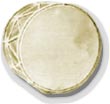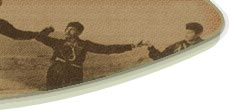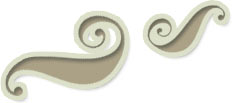|
 
 :
Askompantoura :
Askompantoura
It is the latest version of the very old "askavlos".
It is constituted by leather skin that is useful as space
for air, the wooden valv (sometimes also made of reed or bone),
through which the instrumentalist blows the air, and the appliance
of production of sound, which includes an fluted trough that
leads to a crucible and two pipes, like a type of clarinet
with a single reed and usually 5 holes. Askompantoura is usually
played in the open air, sometimes by its own or with the escort
of lute or small ntaoulaki, or even with other extempore rhythmical
instruments. This instrument was very widespread in the old
times on Crete but unfortunately today it tends to disappear.
A big instrumentalist of the askompantoura is M. Grillos from
Heraklion.
 :
Habioli :
Habioli
It is a type of wooden flute with a side cut part
where the player blows and it is sealed with the "piro"
or souro", a type of plug with a thin slot in order to
leave the air pass. On the roll and where the "piros"
finishes, a usually square hole is opened and then further
down six holes on the front part and one behind that are useful
for the melody. The habioli, mostly a pastoral instrument,
it is usually played by its own. Today it is unfortunately
an instrument that is played from only a few on Crete even
if it is considered to be one of the most Traditional Cretan
Musical Instruments.
 :
Lute :
Lute
The
lute comes from the outi, where it also takes its name (arabic
al oynt = the timber). The lute has four double series of
guitar strings, that tune up in la-re-sol-nto. The Cretan lute usually
accompanies the lyre and not the violin, and it tunes up one
fourth lower, that is mi-la-re-sol. Because of the lower tuning
the whole instrument has grown longer.
The lute of Asia Minor appears that it existed before the
lute of the Hellenic land, and it is presented in the end
of the last century (the lute that is reffered in "Erotokritos"
was rather the European renaissance lute, that appeared to
have too few resemblances with the current Greek lute). In
Crete more specifically, even today it is used many times
as the main instrument of melody even if mainly it is met
in teams with lyre and violin.
 :
Lyre :
Lyre
The
reports of bibliography in this holy instrument begin from
the "Epic of Digeni Akrita" around the 11th Century
a. C. The form of the lyre was not as it is today even if
it is not known how it really was. The only thing sure is
that its manufacture is owed to the will of the people to
maintain for more time the sound that was produced by a string.
This was achieved with the manufacture of a bow, as since
then, the sound was produced by the touch of fingers on the
strings. The "Homeland" of the lyre, that is the
place that it first appeared, is Asia. According to W. Bachmann,
in Asia was found the oldest and less questionable pictorial
document that is dated around the 9th century a.C.
The Lyre is distinguished in Pear-shaped and Bottle-shaped.
The Pear-shaped is mainly presented in the islands of Greece
and Crete while the Bottle-shaped presents in Pontos and Kappadokia.
Distinguished musicologist Lampros Liavas locates the first
depiction of a Pear-shaped lyra in a mural of the 17th/18th
century a.C. in the St Grigorios Abbey of Agion Oros. The
older lyre saved, is of the same season(1743). One of the
oldest musical instruments today in Europe, that is called
"diva" is exhibited in the museum of traditional
instruments (collection of Fivos Anogiannakis).
The lyre is influenced a lot by the violin and thus progressively
we see that a lot of efforts of reconstruction have been made,
so as to remind the violin. A classic example is the manufacture
of the viololyra or lyraviola as it is said around 1960, on
the island of Crete.
The
accompanying musical instrument for lyre on Crete is the lute.
Most times the lute keeps the rhythm for lyre except certain
cases where in Central and Western Crete the lute plays precisely
the same melody as the lyre. In Eastern Crete the accompanying
instruments for the lyre is the guitar, as well as the ntaoulaki.
It's worth saying that in the beginning of the 20th Century
in Rethimno the accompanying instrument for lyre was the Mpoulgari,
master of which was St. Foustalierakis (Foustalieris). The
three strings of the lyre are La, Re, Sol. The materials of
its manufacture are mainly the beech, the mulberry tree, the
ivy, wild pear tree, walnut tree, as well as the maple tree.
 :
Mandolin :
Mandolin
Instrument
of European origin, is met in all the coasts of the Mediterranean.
It is played almost all over Crete and is widely known amongst
its residents. Its appearance is dated by the age of the Venetian
domination on the island. It had a big impression on the residents,
it was used in different variants (e.g. mantola), as an instrument
to accompany the lyre, the violin and the lute. Stelios Foustalierakis
has said that the mandolin and the mpougari were accompanying
the lyre in the beginning of the 20th century in the city
of Rethimno. There are also reports that the mandolin was
mostly a woman's musical instrument as it was the only one
that the women of the island were playing.
Nowadays it is played mainly by its own, in musical teams,
as well as in personal and family events of residents of Crete.
 :
Mpantoura :
Mpantoura
Mpantoura
or mantoura, a wind instrument made of a thin cane (sealed
in an end with a knot and open from the other end), it belongs
in the same category as the klarinet, it has a percussion
reed on the side of the sealed end, which with the blowing
of the mouth produces the sound. Its size usually varies from
20 until 30 cm, while sometimes it is being made of two pieces
of cane: one of them has the holes for the fingers and the
other one, the smallest, has the reed. This allows to the
musician to replace only this part if the reed of body is
destroyed.
Its sound is delicate, more acute than the sound of the hampioli,
because the cane is thinner. Its possibilities are limited
in certain musical phrases and impromptus.
The mpantouras were manufactured off-handedly by the children
in the villages with their pocketknives and played simple
melodies from the few things they knew. Two mpantouras together,
make a twin mpantoura, or a double mpantoura. Usually the
one of the two mpantouras, has only a hole, mr. Anogiannakis
however reports a twin mpantoura with all of its the holes
in both of its parts from the region of Prine, at Milopotamos
in Rethymnon. Over the last years of the middle war there
is a slight enforcement of its sound: instead of one mpantoura,
they played two together.
In
this instrument, when the two mpantouras won't sound as one,
they used various ways to tune the two mantouras: they were
scratching it with a knife, so as to make one of the two reeds
thinner, or, in the one of the two mantouras they were placing
under its reed a thin spinner or they were wrapping three
to four times the base of the reed with a thin spinner, which
after that, they would tied up in a knot. Both ways were influencing
the palmic move of the reed, and consequently the tone of
the sound. Some times they would also open or close using
a little with wax, whichever from the holes would not co-ordinate
soundly with the corresponding hole of the other mantoura.
 :
Mpoulgari :
Mpoulgari
Mpoulgari
is a type of tampoura that is found on Crete and Turkey. The
Sumerian name pan-tour (small arrow) appears to be even today
the prevailing one for this instrument. Mpouzouki belongs
in this family of instruments. On Crete its main representative
is considered to be Stelios Foustalierakis (1911-1992) from
Rethimno, with "the tampahaniotika" that was the
cause to introduce mpoulgari into discography.
 :
Ntaoulaki :
Ntaoulaki
It
is a small ntaouli that is played with two sticks, the "ntaouloxyla",
and accompanies the lyre or the violin. In the old days it
was very widely known, especially on the Eastern Crete, while
today it has almost disappearred. Nikolaos Panagiotakis reports
testimonies from the times of the Venetian Domination, where
the ntaoulaki is one of the instruments that were used in
the popular feasts of the countryside at that time.
 :
Violin :
Violin
An instrument with a world wide impression, that
exists for 400 years in his current form. On Crete it is met
before the years of the Venetian domination. There is a gravure,
since 1260, that it depicts a Cretan man playing the violin
in some other form of course, as there are handscripts in
the Rumanian Academy that contain pictures of Erotokritos
with musicians of that season that play the violin.
The violin was the most popular instrument in the prefectures
of Lasithi, Heraklion and Chania until 1940. In the prefecture
of Heraklion receded after the civil war. However in the prefectures
of Lasithi and particularly in Chania it still plays a fundamental
role. As a four-stringed instrument with notes Mi La Re Sol,
it has for sure, more possibilities than the lyre. The most
basic melodies of Cretan music have been first played and
composed on the steps of the violin.
Kontilies, Sirtos, Pentozali, Pirrihios, Ortses, Apanomeritis,
Zervodexos and Pidiktoi (Stiakos and Kastrinos): With unique
virtuosity these melodies are played on the violin and surely
the steps and the turnings cannot be made with the lyra.
Stratis
Kalogeridis, Dermitzogiannis, Avissinos, Vekios, Mparintantonakis,
Perakis, Kotsakis, are certainly from the greatest virtuosos
that flourished or still continue this tradition on Eastern
Crete.
Stef.
Triantafillakis(Kioros), Matzouranas, Mpalampos, konstantine
Mpoultadakis (Kanarinis), G. Marianos, Harhalis, Felesogiannis,
N. Saridakis (Mauros), K. Papadakis (Nautis), Mih. Kounelis,
F. Katrakis, are some of the violinists that acted or still
continue their work on Western Crete.
We
realize that the violin fell into the hands of many and big
musicians that marked the Cretan musical tradition. The violin
therefore, was unfairly removed from the musical stage of
Crete since 1950 and afterwards, despite the history and the
tradition that for centuries is kept live until our days and
indisputably proves the value of this misjudged musical instrument.
 :
Viololira :
Viololira
Violin-look alike lyre, that was created around
1920-25 as an effort the lyre to obtain the sound and the
technical possibilities of the violin. It was particularly
used in the prefecture of Heraklion where even today it is
still met in certain regions.
|


|





